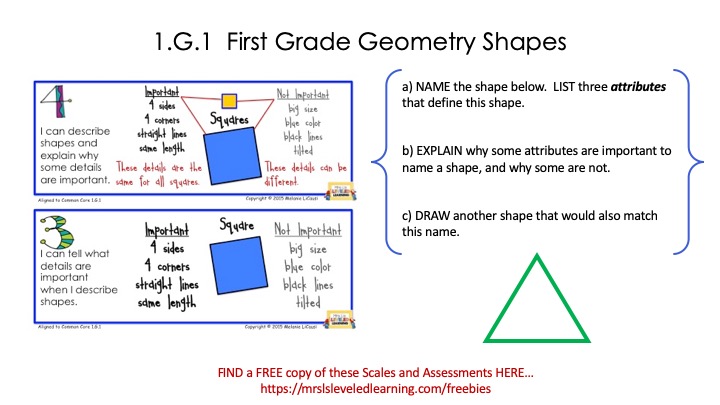Proficiency Scales are all about helping students show growth in small steps instead of being overwhelmed by a year-end goal that seems way over their head. Standards based grading means that you can pre-assess and post-assess your elementary students to document this progress. This video will walk you through one way to get your students understanding the scale. In this first grade geometry scale, students are supposed to identify the important aspects of shapes, the defining aspects of shapes. We are going to start with a level one problem for first graders, which means thinking about what the characteristics or attributes of shapes might be that make them similar and different. Here’s an example problem that you can ask your students to see if they remember maybe things from kindergarten or preschool.
Level 1
List two things that are the same between the shapes above. You might notice that these shapes have a certain number of sides, straight sides, curvy sides, a certain, number of corners. They have different shapes and they might have different names that you can think of. You are going to write two things that are the same between the shapes.
Next, you’re going to list two things that are different between the shapes above. Take one minute to write something down on your paper. Your teacher will let you know when it’s time to share.
In this level one problem, students should be able to identify some of the basic features of shapes.
Level 2
At the second level of the scale, students should be able to identify features of shapes, but also what features are important. What features start to define a shape as a circle, a triangle, a square, etc. and what features don’t really matter. Their first job is to circle one object below that has something similar with this circle.
Students might notice that every single object has some similar features to a circle, but some things are missing or different. Give them a chance to share with each other, to share with you out loud or to write something down on their paper that gives you an idea of who understands this so far.
Their second task would be to explain why the object is similar to a circle. What features in this first shape remind students of a circle and which features would be wrong or not included? Move to the second shape and ask the same thing. Which features match the shape of a circle and which ones don’t fit. Move to the third shape and ask the same thing. You’ll notice the example on the scale. Students can tell that the first triangle is not really a triangle because it’s an open shape, but the two triangles in the boxes are triangles because they’re closed and I have some defining features. In the example, they have three sides and they have three corners. You can ask your students to identify the defining shapes of a circle and see if they get it yet because that will be their task for this year.
Level 3
At level three, this is the grade level objective. You want your students to be able to tell you all the features of a shape, sides, corners, colors, lengths, and decide which ones are important. So you’ll see in the example of the scale, the important features are highlighted. The square has four sides, four corners, straight lines, and all the lines are the same length. The features that are not important is whether it’s big or small, that it’s blue, whether the lines are black or slanted or square with the table.
Some of the dimensions of this square are not important to identifying the shape. Students need to know which ones. Here’s the question. You can ask them to see if they’ve got it.
Name the shape above lists. Three attributes for this shape.
Attributes could also be characteristics. Use a couple of different words and see which ones your students identify with and then make sure that they know the vocabulary that’s necessary for this year standard. You can have them write this on a piece of paper, or share with a partner. They may also share in a small group or raise their hands and tell you a loud.
Next, ask them to circle the attributes on their list that they think are the most important to describing this shape or naming this shape. Make sure that they can explain it. If students can do all of these things, then they’ve definitely mastered the grade level expectation for this scale. If your students are doing really well at level three, you can challenge them to try level four. If they’re not ready, you might want to stop there and start your lesson for the day.
This assessment can be great as a pre-assessment, to determine whether or not your students are already at grade level, below grade level or are going to need a challenge this year.
Level 4
Let’s take a look at level four just in case you have students that come in at grade-level mastery.
At level four, students have to be able to explain why some of the attributes are important or not and they should be able to do this with multiple shapes. So here’s another example that’s different from the scale on the left.
Name the shape below lists three attributes that define this shape. So already students should know which attributes define the shape and which ones would not. Explain why some attributes are important to name a shape and why some are not. Draw another shape that would also match this name.
So students should be able to identify a variety of shapes that have the same defining attributes even if some of their other attributes vary. If your students can do all these things, they are already functioning above the grade level expectation for this first grade standard. This is a great activity to extend learning for your high students or ones that already know the information while you work with some of the lower ones. I hope you found this example helpful.
You can find this resource in my TpT store. Follow the links to download a FREE Leveled Assessment and FREE Scales for this math standard and more!
Thank you to Natalie F. for your feedback!
“This is an amazing resource! I have been looking for a resource like this for a long time. It will make my life so much easier trying to assess math! Thank you for sharing!” – November 2018
Not sure yet?
DOWNLOAD the FREE PREVIEW from each page to try in your classroom
first!
I welcome any feedback for improvements on TpT or comment below.
I’ve gotten great feedback so far and I’d love to see how you’re using these in your classroom! Feel free to post a picture on my Facebook page or Facebook discussion group! (Differentiation with Proficiency Scales)
Follow me on Instagram. to get updates!
I look forward to seeing you around! 😉



